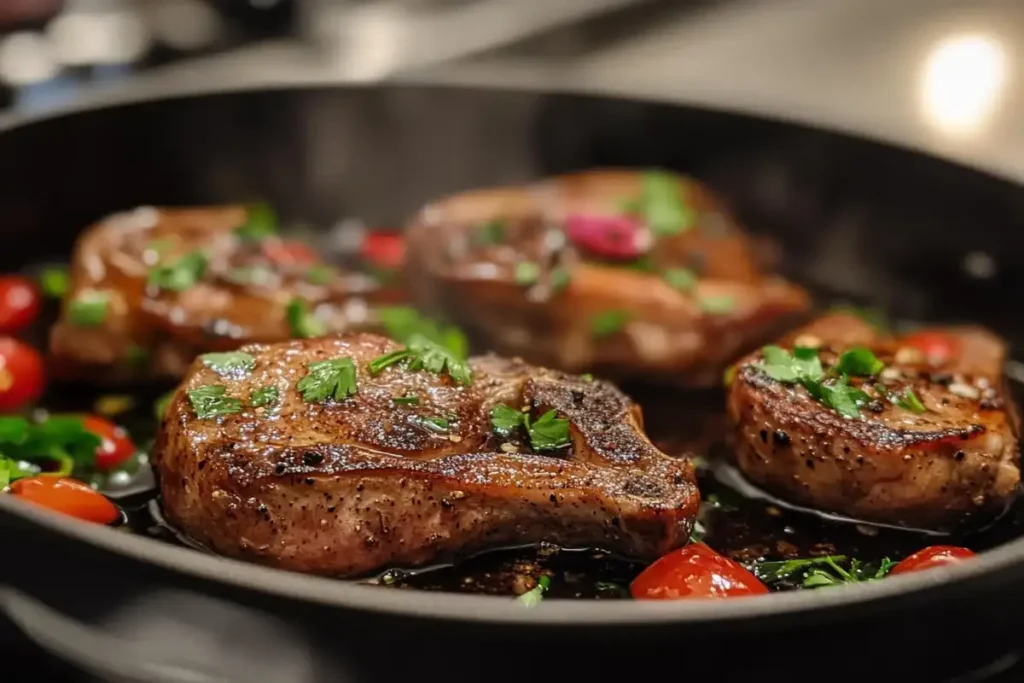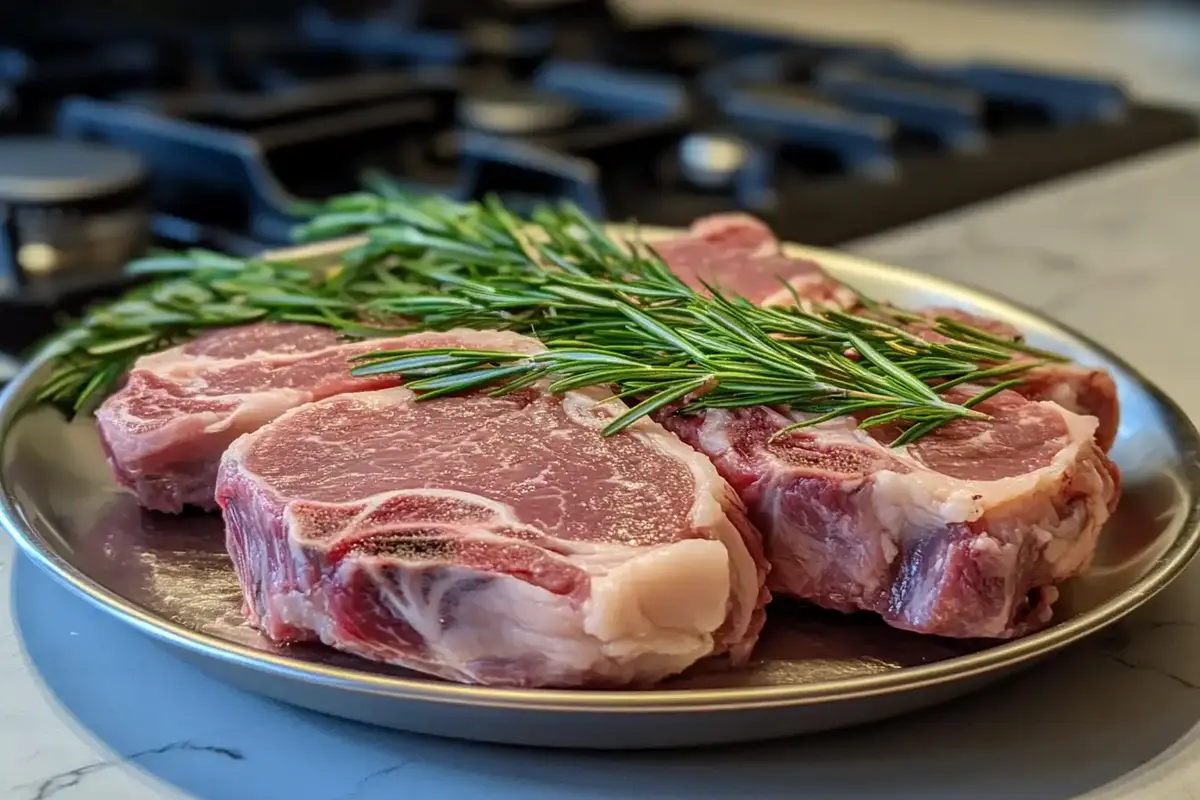Lamb shoulder chops are a hidden gem in the culinary world. With their rich, tender texture and intense flavor, they’re perfect for creating hearty and satisfying meals. Whether you’re a seasoned chef or someone trying their hand at cooking lamb for the first time, this guide will walk you through every detail, from selecting quality chops to serving them with mouthwatering side dishes. Along the way, we’ll cover expert tips, common pitfalls, and various cooking methods, ensuring your lamb shoulder chop recipe turns out flawless. Ready to dive into the world of lamb deliciousness? Let’s get started!
Lamb Shoulder Chop Recipe
Overview of Lamb Shoulder Chops
What Are Lamb Shoulder Chops?
Lamb shoulder chops, cut from the shoulder of the lamb, are known for their marbled texture and bold flavor. Unlike more tender cuts like lamb loin chops, shoulder chops require a bit more attention during preparation and cooking. But when handled properly, they deliver an exceptional depth of flavor that elevates any meal.
Often overlooked, these chops are more affordable than other lamb cuts, making them a budget-friendly yet gourmet option. The unique marbling in the meat ensures each bite is juicy, especially when cooked using methods that enhance their natural tenderness, such as braising or slow cooking.
Nutritional Value of Lamb Shoulder Chops
Rich in essential nutrients, lamb shoulder chops are a powerhouse of protein, iron, and zinc. They provide vitamins like B12, crucial for energy and brain function. Additionally, lamb is an excellent source of selenium, which supports a healthy immune system. However, they are also higher in fat compared to leaner cuts, so portion control is key for balanced meals.
When served with fresh vegetables or whole grains, lamb shoulder chops can be part of a wholesome, nutrient-rich diet. Need a deeper dive into the nutritional profile?
Selecting the Perfect Lamb Shoulder Chops
How to Choose Quality Lamb Shoulder Chops
When it comes to cooking lamb shoulder chops, starting with high-quality meat is crucial. The flavor, texture, and tenderness of your final dish depend heavily on the freshness and cut of the lamb. Here’s how to ensure you’re picking the best chops:
Understanding Different Cuts
Lamb shoulder chops come in various sizes and thicknesses, each suited for different cooking methods. Look for chops with ample marbling – those thin streaks of fat running through the meat – as they contribute to juiciness and flavor during cooking. Thicker cuts are ideal for slow cooking, while thinner chops are perfect for grilling or pan-searing.
Not sure which to choose? Consult your local butcher. They can guide you to the right cut based on your preferred cooking method. Plus, freshly butchered lamb often outshines pre-packaged meat in terms of flavor.
Signs of Freshness in Lamb Meat
Fresh lamb shoulder chops should have a vibrant pink to deep red color, depending on the age of the lamb. Avoid meat with a grayish or brownish hue, as it may be past its prime. The fat should be creamy white, firm, and evenly distributed.
Additionally, fresh lamb has a clean, mild aroma. If the meat has a sour or overly strong smell, it’s best to pass on it. Always check the packaging date and opt for cuts labeled as grass-fed or pasture-raised for superior flavor and nutrition.
Preparing Lamb Shoulder Chops
Essential Ingredients for Lamb Shoulder Chop Recipe
To craft a delicious lamb shoulder chop dish, you’ll need a mix of basic pantry staples and aromatic herbs and spices. The right combination will bring out the natural flavors of the meat while adding layers of complexity.
Herbs and Spices for Flavor Enhancement
The key to enhancing the flavor of lamb shoulder chops lies in the choice of seasonings. Classic herbs like rosemary, thyme, and oregano pair beautifully with lamb’s robust taste. Garlic, paprika, and ground cumin are also excellent additions, adding depth and a touch of smokiness.
For a fresh burst of flavor, incorporate lemon zest or fresh parsley. Salt and pepper are, of course, non-negotiables, as they form the foundation of any well-seasoned dish.
Marinating Techniques for Tenderness
Marinating lamb shoulder chops is an essential step to ensure tenderness and amplify flavor. Combine olive oil, lemon juice, garlic, and your choice of herbs and spices for a simple yet effective marinade. Allow the chops to soak for at least 2 hours, but overnight marination yields the best results.
For even better absorption, pierce the meat lightly with a fork before marinating. This allows the seasonings to penetrate deeply, ensuring every bite is flavorful. Ready for some expert tips on marination?
Cooking Methods
Various Cooking Techniques for Lamb Shoulder Chops
Lamb shoulder chops are incredibly versatile, lending themselves to a range of cooking techniques. From a quick pan-sear to slow braising, there’s a method to suit every palate. Each approach unlocks unique textures and flavors, making these chops a favorite for creative cooking.
Pan-Seared Lamb Shoulder Chops
Pan-searing is perfect for achieving a beautifully caramelized crust while keeping the inside juicy and tender. Start by heating a cast-iron skillet over medium-high heat and adding a drizzle of olive oil. Season the chops generously with salt, pepper, and a pinch of paprika.
Place the chops in the skillet and sear for 3–4 minutes on each side until golden brown. Reduce the heat, add a knob of butter, crushed garlic, and a sprig of rosemary, and baste the chops with the melted butter. Cook until the internal temperature reaches 145°F (63°C) for medium-rare.

Oven-Baked Lamb Shoulder Chops
For evenly cooked, fall-off-the-bone lamb, baking is an excellent method. Preheat your oven to 375°F (190°C). Arrange the chops on a baking dish and drizzle with olive oil. Sprinkle minced garlic, thyme, and a touch of lemon zest over the meat.
Cover the dish with foil and bake for 25–30 minutes, then remove the foil to let the chops brown for an additional 5–10 minutes. Serve hot with roasted vegetables or a light salad.
Grilled Lamb Shoulder Chops
Grilling adds a smoky, charred flavor that pairs perfectly with lamb’s richness. Preheat your grill to medium-high and oil the grates. Marinate the chops beforehand for extra flavor.
Grill the chops for about 4–5 minutes per side, depending on their thickness, and rotate halfway through to create grill marks. Rest the chops for 5 minutes after grilling to allow the juices to redistribute before serving.
Braised Lamb Shoulder Chops
Braising is ideal for tougher cuts like lamb shoulder chops, as it breaks down connective tissue, leaving the meat tender and flavorful. Start by searing the chops in a Dutch oven with olive oil. Remove and set aside.
In the same pot, sauté onions, garlic, and carrots until softened. Deglaze with chicken stock and add tomatoes, fresh herbs, and a splash of lemon juice. Return the chops to the pot, cover, and simmer on low heat for 1.5–2 hours. Serve with crusty bread or mashed potatoes.
Step-by-Step Recipe Guide
Detailed Recipe for Lamb Shoulder Chops
Ingredients List
- 4 lamb shoulder chops
- 2 tbsp olive oil
- 4 cloves garlic, minced
- 2 tsp fresh rosemary, chopped
- 1 tsp thyme
- 1 tsp paprika
- Salt and black pepper to taste
- Lemon wedges (for garnish)
Preparation Steps
- Pat the lamb shoulder chops dry with a paper towel to remove excess moisture.
- In a small bowl, combine olive oil, minced garlic, rosemary, thyme, paprika, salt, and pepper.
- Rub the marinade evenly over both sides of the lamb chops. Allow them to marinate for at least 2 hours or overnight for maximum flavor.
Cooking Instructions
- Heat a large skillet or grill pan over medium-high heat. Add a drizzle of olive oil to prevent sticking.
- Place the lamb chops in the pan and cook for 3–4 minutes on each side until golden brown. Reduce the heat slightly to avoid burning.
- For an even cook, cover the pan with a lid and let the chops finish cooking for an additional 5–7 minutes. Check the internal temperature; it should reach 145°F (63°C) for medium-rare.
- Remove the chops from the heat and rest for 5 minutes. This step ensures the juices redistribute, keeping the meat tender.
- Serve hot, garnished with lemon wedges and a sprinkle of fresh parsley.
Serving Suggestions
Ideal Side Dishes for Lamb Shoulder Chops
Lamb shoulder chops pair wonderfully with a variety of side dishes, transforming your meal into a feast of textures and flavors. The robust nature of lamb lends itself to bold accompaniments, making it easy to create a well-rounded plate.
Vegetable Pairings
Vegetables are a classic choice for complementing the rich flavor of lamb shoulder chops. Roasted vegetables like carrots, zucchini, and Brussels sprouts, seasoned with olive oil and rosemary, add a caramelized sweetness.
For a lighter touch, steamed asparagus or sautéed green beans with garlic work beautifully. For a vibrant pop of color and a Mediterranean flair, consider a fresh tomato and cucumber salad with a drizzle of lemon vinaigrette.

Grain and Starch Accompaniments
Grains and starches provide a hearty base for lamb dishes. Creamy mashed potatoes or roasted fingerling potatoes seasoned with thyme offer a comforting pairing.
For something more adventurous, try couscous or quinoa tossed with herbs and dried fruits, echoing Middle Eastern flavors. Rice pilaf or polenta are also excellent choices, soaking up the juices from the lamb for a delicious, cohesive dish.
Tips and Tricks
Expert Tips for Perfect Lamb Shoulder Chops
Creating the perfect lamb shoulder chops isn’t just about the recipe; it’s also about technique. These expert tips ensure your dish comes out flavorful and tender every time.
Achieving Desired Doneness
Monitoring the internal temperature of your lamb chops is key to achieving the perfect level of doneness. Use a meat thermometer for accuracy: 145°F (63°C) for medium-rare, 160°F (71°C) for medium, and 170°F (77°C) for well-done.
Avoid overcooking, as it can make the chops dry and tough. For an extra burst of flavor, baste the chops with butter and fresh herbs during cooking. This not only enhances the taste but also helps maintain moisture.
Resting the Meat Before Serving
Resting lamb shoulder chops after cooking is a step you shouldn’t skip. Allow the meat to rest for 5–10 minutes before slicing or serving.
This rest time allows the juices to redistribute evenly throughout the meat, ensuring each bite is juicy and flavorful. Cover the chops loosely with foil while resting to retain heat without trapping steam, which could soften the crust.
Common Mistakes to Avoid
Pitfalls in Cooking Lamb Shoulder Chops
Cooking lamb shoulder chops can seem intimidating, especially if you’re unfamiliar with this cut. Avoiding common mistakes ensures your dish is flavorful, tender, and satisfying. Here’s what to watch out for:
Overcooking or Undercooking
One of the most frequent errors is either overcooking or undercooking the chops. Overcooked lamb becomes dry and chewy, while undercooked chops can have an unappealing texture. To get it just right, use a meat thermometer.
Always target an internal temperature of 145°F (63°C) for medium-rare or 160°F (71°C) for medium. And remember, the chops will continue to cook slightly while resting, so pull them off the heat a few degrees early.
Insufficient Seasoning
Lamb shoulder chops have a robust flavor, but that doesn’t mean you can skimp on seasoning. Under-seasoning leaves the meat tasting bland and unbalanced.
Generously season both sides with salt and pepper to enhance the natural flavors, and don’t shy away from using aromatic herbs like rosemary or thyme. If you’re marinating, ensure the chops are well-coated and have enough time to absorb the flavors.
Health Considerations
Health Benefits and Considerations
Lamb shoulder chops are not only delicious but also packed with nutrients, making them a wholesome addition to your diet. However, like any rich dish, balance is essential for enjoying these benefits.
Protein and Nutrient Content
Lamb is an excellent source of high-quality protein, essential for muscle repair and growth. It’s also rich in iron, zinc, and vitamin B12, all vital for energy production, immune health, and red blood cell formation.
Additionally, lamb contains selenium, a powerful antioxidant that supports overall health. Including lamb shoulder chops in your meals provides a nutrient boost that complements an active lifestyle.
Managing Fat Intake
While lamb is nutrient-dense, it’s also higher in fat, particularly saturated fat, than some other proteins. To enjoy lamb shoulder chops healthily, trim visible fat before cooking.
Pair the meat with fiber-rich vegetables and whole grains to balance the meal and aid digestion. Opting for methods like grilling or baking can also reduce excess fat compared to frying.
Frequently Asked Questions (FAQs)
FAQs about Lamb Shoulder Chop Recipes
Lamb shoulder chops can sometimes raise questions, especially for home cooks who are new to this cut. Below are answers to the most common inquiries to help you cook with confidence.
What is the best way to tenderize lamb shoulder chops?
Tenderizing lamb shoulder chops ensures they’re soft and flavorful. Marinating is one of the best methods, combining acidic ingredients like lemon juice or yogurt with olive oil, garlic, and herbs. The acidity breaks down muscle fibers, making the meat more tender.
Alternatively, using a meat mallet to gently pound the chops can help. Slow cooking or braising also works wonders by breaking down the tough connective tissues over time, resulting in melt-in-your-mouth texture.
How long should I marinate lamb shoulder chops?
For optimal flavor and tenderness, marinate lamb shoulder chops for at least 2 hours. However, overnight marination (up to 24 hours) is ideal for allowing the flavors to deeply penetrate the meat.
Keep the marinated chops refrigerated in an airtight container or sealed plastic bag. Avoid marinating for too long (more than 24 hours), as excessive acidity can alter the meat’s texture, making it mushy instead of tender.
Can I cook lamb shoulder chops from frozen?
Yes, you can cook lamb shoulder chops from frozen, but it requires some adjustments. Cooking from frozen takes longer, so plan for an additional 50% of the usual cooking time.
For best results, thaw the chops in the refrigerator overnight. This ensures even cooking and reduces the risk of a dry or uneven texture. If you’re short on time, use the defrost function on your microwave to safely thaw the chops before cooking.
What internal temperature should lamb shoulder chops reach?
The USDA recommends cooking lamb shoulder chops to an internal temperature of 145°F (63°C) for medium-rare, 160°F (71°C) for medium, and 170°F (77°C) for well-done. Use a meat thermometer to check the temperature accurately.
Insert the thermometer into the thickest part of the chop, avoiding any bones, to get a true reading. Remember to allow the chops to rest for a few minutes after cooking, as they will continue to cook slightly during this time.
How can I reduce the gamey flavor of lamb?
The gamey flavor in lamb is often due to its natural fat content. To reduce this, trim excess fat from the chops before cooking. Marinating the meat with ingredients like garlic, rosemary, and lemon juice also helps mellow the strong flavor.
Cooking lamb with bold spices such as cumin or paprika can mask any gaminess, creating a balanced and enjoyable flavor profile. Additionally, pairing lamb with acidic or fresh sides, like a yogurt-based sauce or citrusy salad, can complement and offset its richness.
Are lamb shoulder chops suitable for slow cooking?
Absolutely! Lamb shoulder chops are perfect for slow cooking due to their marbled texture and higher connective tissue content. Slow cooking breaks down the collagen, resulting in tender, flavorful meat that practically falls off the bone.
Use a slow cooker or a covered pot on low heat for 6–8 hours. Add aromatics like onions, garlic, and herbs, along with a liquid base such as broth or tomato sauce, to infuse the chops with flavor as they cook.

